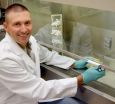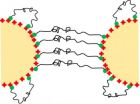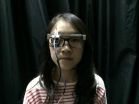(Press-News.org) MANHATTAN, Kansas — He calls himself the bug hunter, but the target of his work consists of viruses that can only be found and identified with special methods and instruments. Benjamin Hause, an assistant research professor at the Kansas State Veterinary Diagnostic Laboratory at Kansas State University, recently published an article about one of his discoveries, porcine enterovirus G, which is an important find in the United States.
"We had isolated a virus in cells, but didn't know what it was," Hause said. "We used next-generation sequencing to identify it, and it turned out to be porcine enterovirus G, which had been described before but had never previously been found in North America."
The virus is thought to be benign and is not known to cause disease, but it had only been reported before in Europe and Asia.
"Fortunately porcine enterovirus G doesn't do much in pigs, but it raises concerns about other viruses getting through the border," Hause said. "We're not sure if this has been here for some time undetected or is a recent introduction. Coincidentally, the virus was most similar to 2012 Chinese isolates and was detected around the same time as a couple of other viruses: porcine epidemic diarrhea virus and porcine deltacoronavirus, both of which were detected in China in the same time frame prior to the U.S."
Both porcine epidemic diarrhea virus and porcine deltacoronavirus have caused major economic losses to hog producers in North America and are impacting several other aspects of the swine industry. Hause has mapped these viruses at the Kansas State Veterinary Diagnostic Laboratory as a way to ensure the reliability of the next-generation sequencing methods he uses to identify and characterize pathogens. The technique will soon be offered at the laboratory.
"As we isolate viruses, we can completely sequence their genomes," Hause said. "We can get a good understanding of what makes those viruses tick. Next-generation sequencing goes farther and allows us to perform metagenomic sequencing where we don't isolate the virus. Instead, we can sequence all DNA contained in a sample, which includes the host DNA, plus it reads all of the viruses in the sample too. It's a universal method to detect viruses that we have adapted and applied to veterinary diagnostics."
Hause's most recent work has led to the discovery of an influenza virus in cattle.
"A swine sample came in that we thought was influenza, but all other tests were negative," Hause said. "We found instead that this was an entirely new type of influenza. Subsequent research has shown that it is widespread in cattle, not just pigs. Now we're studying the association of this strain of bovine influenza with respiratory disease in feedlots."
Before joining Kansas State University in May, Hause was the diagnostic lab director at Newport Labs in Worthington, Minnesota. He worked on his porcine enterovirus G paper with Richard Hesse, a diagnostic virologist at the Kansas State Veterinary Diagnostic Laboratory, who helped recruit Hause to the university to further develop his next-generation sequencing methodology, which has other benefits from identifying and characterizing pathogens.
"As a virus mutates and changes, next-generation sequencing can be used to help update vaccines so they are still effective," Hause said. "Through this technology we can build a database with a collection of viruses based on where they came from and what kind of clinical presentation was seen. Then we can mine that dataset to match the vaccines or to get additional information on the pathogen. Some diseases such as flu mutate and change rapidly, and can jump from humans to pigs and back to humans, so it's important for both animal health and human health that we monitor and understand these viruses as much as possible."
The article on porcine enterovirus G, "First Identification and Characterization of Porcine Enterovirus G in the United States," was published in the journal PLOS ONE, http://bit.ly/1t3IfzL.
INFORMATION: END
Researcher using next-generation sequencing to rapidly identify pathogens
2014-07-28
ELSE PRESS RELEASES FROM THIS DATE:
Preschoolers with special needs benefit from peers' strong language skills
2014-07-28
The guiding philosophy for educating children with disabilities has been to integrate them as much as possible into a normal classroom environment, with the hope that peers' skills will help bring them up to speed. A new study provides empirical evidence that peers really can have an impact on a child's language abilities, for better or worse.
While peers with strong language skills can help boost their classmates' abilities, being surrounded by peers with weak skills may hinder kids' language development.
The findings are published in Psychological Science, a journal ...
Unhealthy habits more than double risk of metabolic syndrome in childhood cancer survivors
2014-07-28
A St. Jude Children's Research Hospital study found that 73 percent of adult survivors of childhood cancer more than doubled their risk of developing metabolic syndrome and related health problems by failing to follow a heart-healthy lifestyle. The results appear in the current issue of the journal Cancer.
Almost 32 percent of the 1,598 adult survivors of childhood cancer in the study had metabolic syndrome, an umbrella term for health risk factors like high blood pressure, abdominal obesity, elevated triglyceride and other abnormalities that often occur together. The ...
Seeing is bead-lieving
2014-07-28
HOUSTON – (July 28, 2014) – Rice University researchers are using magnetic beads and DNA "springs" to create chains of varying flexibility that can be used as microscale models for polymer macromolecules.
The experiment is visual proof that "bead-spring" polymers, introduced as theory in the 1950s, can be made as stiff or as flexible as required and should be of interest to materials scientists who study the basic physics of polymers
The work led by Rice chemical and biomolecular engineer Sibani Lisa Biswal and graduate student Julie Byrom was published this month in ...
Mutations from Venus, mutations from Mars
2014-07-28
Some 15% of adults suffer from fertility problems, many of these due to genetic factors. This is something of a paradox: We might expect such genes, which reduce an individual's ability to reproduce, to disappear from the population. Research at the Weizmann Institute of Science that recently appeared in Nature Communications may now have solved this riddle. Not only can it explain the high rates of male fertility problems, it may open new avenues in understanding the causes of genetic diseases and their treatment.
Various theories explain the survival of harmful mutations: ...
Measuring the smallest magnets
2014-07-28
Imagine trying to measure a tennis ball that bounces wildly, every time to a distance a million times its own size. The bouncing obviously creates enormous "background noise" that interferes with the measurement. But if you attach the ball directly to a measuring device, so they bounce together, you can eliminate the noise problem.
As reported recently in Nature, physicists at the Weizmann Institute of Science used a similar trick to measure the interaction between the smallest possible magnets – two single electrons – after neutralizing magnetic noise that was a million ...
Social network research may boost prairie dog conservation efforts
2014-07-28
Researchers using statistical tools to map social connections in prairie dogs have uncovered relationships that escaped traditional observational techniques, shedding light on prairie dog communities that may help limit the spread of bubonic plague and guide future conservation efforts. The work was done by researchers from North Carolina State University and the National Evolutionary Synthesis Center (NESCent).
"Prairie dogs are increasingly rare and are subject to bubonic plague," says Dr. Jennifer Verdolin, lead author of a paper on the work and an animal behavior ...
Motivation explains disconnect between testing and real-life functioning for seniors
2014-07-28
A psychology researcher at North Carolina State University is proposing a new theory to explain why older adults show declining cognitive ability with age, but don't necessarily show declines in the workplace or daily life. One key appears to be how motivated older adults are to maintain focus on cognitive tasks.
"My research team and I wanted to explain the difference we see in cognitive performance in different settings," says Dr. Tom Hess, a professor of psychology at NC State and author of a paper describing the theory. "For example, laboratory tests almost universally ...
Wearable device for the early detection of common diabetes-related neurological condition
2014-07-28
WASHINGTON, July 28, 2014—A group of researchers in Taiwan has developed a new optical technology that may be able to detect an early complication of diabetes sooner, when it is more easily treated. If the device proves safe and effective in clinical trials, it may pave the way for the early detection and more effective treatment of this complication, called diabetic autonomic neuropathy, which is common among people with both Type 1 and Type 2 diabetes. The condition progressively affects the autonomic nerves controlling vital organs like the heart and gastrointestinal ...
Potential 'universal' blood test for cancer discovered
2014-07-28
Researchers from the University of Bradford, UK, have devised a simple blood test that can be used to diagnose whether people have cancer or not.
The test will enable doctors to rule out cancer in patients presenting with certain symptoms, saving time and preventing costly and unnecessary invasive procedures such as colonoscopies and biopsies being carried out. Alternatively, it could be a useful aid for investigating patients who are suspected of having a cancer that is currently hard to diagnose.
Early results have shown the method gives a high degree of accuracy ...
Gender inequalities in health: A matter of policies
2014-07-28
A new study of the European project SOPHIE has evaluated the relationship between the type of family policies and gender inequalities in health in Europe. The results show that countries with traditional family policies (central and southern Europe) and countries with contradictory policies (Eastern Europe), present higher inequalities in self-perceived health, i.e. women reported poorer health than men. Health inequalities are especially remarkable in Southern Europe countries, where women present a 27% higher risk of having poor health compared to men.
The authors of ...






